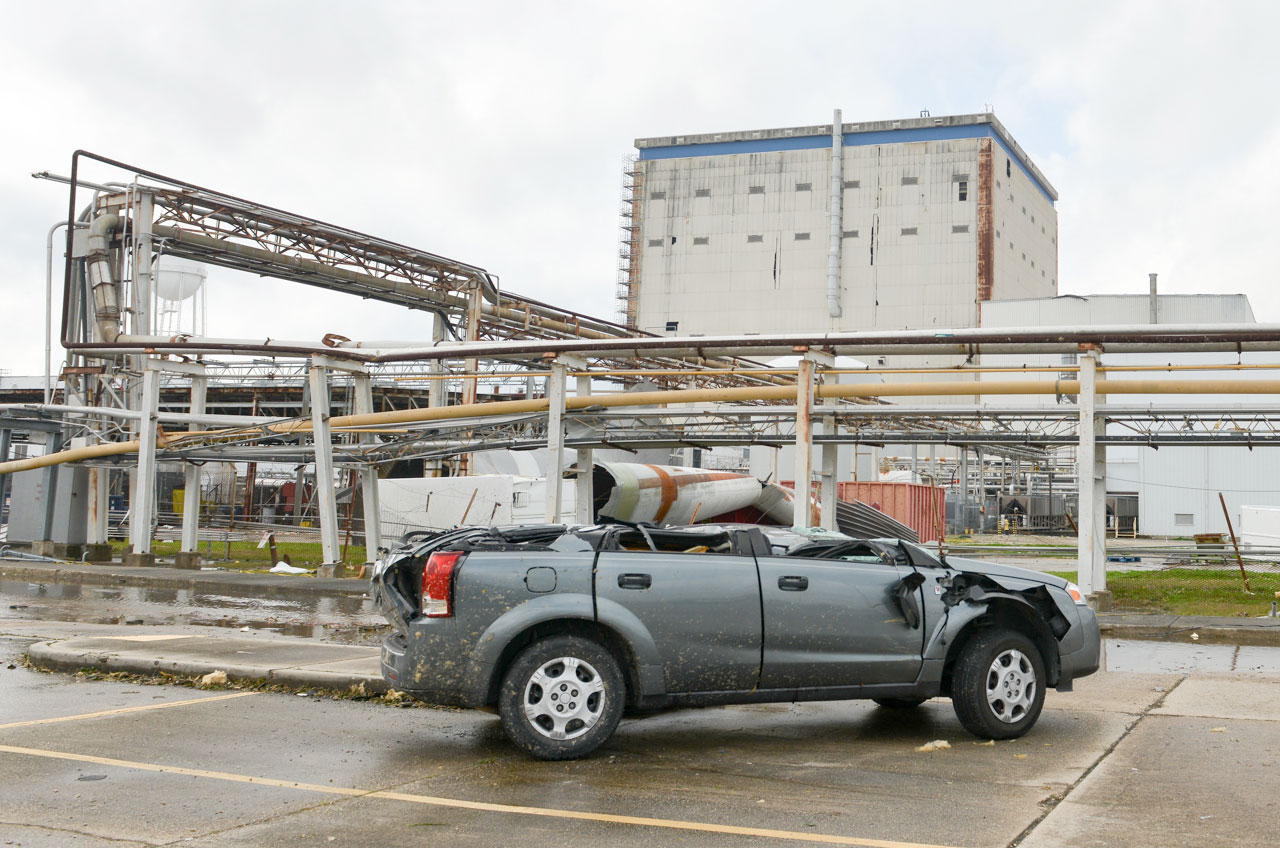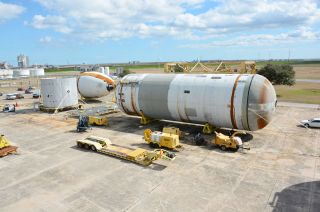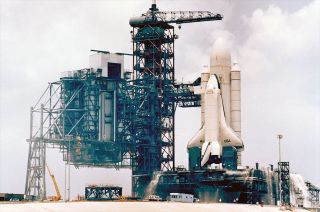Tornado Destroys First NASA Space Shuttle External Tank to Stand on Launch Pad

NASA's first space shuttle external tank to stand on a launch pad was destroyed on Tuesday (Feb. 7) when a tornado impacted the New Orleans facility where it was built 40 years ago.
The external tank-ground vibration test article (ET-GVTA) was in outdoor storage at the Michoud Assembly Facility in Louisiana when the storm hit the site at Tuesday morning. Reports of the tank being "sent flying and destroyed" were shared by people at the facility.
Five people, out of the facility's 3,500 employees, suffered minor injuries as a result of the tornado, which left several structures and about 200 cars with damage. The facility's main manufacturing building sustained damage to its roof, but the hardware for NASA's Space Launch System (SLS) heavy-lift rocket and Orion spacecraft were unaffected, per an early assessment by the space agency. [In Photos: Tornado Damage at NASA's Michoud]
The tornado was one of at least seven that were reported to have touched down in southeast Louisiana on Tuesday.
"The safety of our team is always our main concern," said Keith Hefner, director of the Michoud Assembly Facility, in a statement released by NASA on Tuesday. "Our hearts go out to our employees and the people in New Orleans who have suffered from this serious storm."

Founded in 1940 to build wooden airplanes for World War II, the Michoud Assembly Facility was transferred to NASA control in 1961 to support construction of the massive first stages for the Saturn IB and Saturn V rockets used during the Apollo program. After the missions to the moon ended, the facility produced the external tanks for the 135 space shuttle missions.
ET-GVTA was one of the first three external tanks that was manufactured at Michoud. Built to represent a flight article, it was not covered in insulating foam like those that would later launch to space, but was painted white.
Get the Space.com Newsletter
Breaking space news, the latest updates on rocket launches, skywatching events and more!
"ET-GVTA played a critical role in the early testing for the space shuttle," said Dennis Jenkins, the author of the new book, "Space Shuttle: Developing an Icon, 1972-2013" and a former project manager for the space shuttle program. "It was the subject of several iconic photos."
First used with the prototype orbiter Enterprise for a series of vibration tests at NASA's Marshall Space Flight Center in Alabama, ET-GVTA helped establish the bending modes and nodal crossing points to validate various analyses and locate the rate gyros and accelerometers used by the flight control system.
It was then moved to the Kennedy Space Center in Florida for a series of facility verification tests, culminating with it being paired with two solid rocket boosters and mounted to Enterprise in the Vehicle Assembly Building and moving to Launch Complex 39A for the first time.

ET-GTVA was subsequently shipped back to Louisiana for its possible refurbishment into a flight tank, but that did not happen. Instead, it was disassembled and its liquid oxygen and liquid hydrogen tanks, as well as its interstage, were put into storage, eventually being parked outside Building 103, the facility's main manufacturing building.
"Reportedly, NASA intended to use the pieces of ET-GVTA for an exhibit showing the major structures of the external tank — something that will obviously not happen," Jenkins wrote in an email to collectSPACE.
Of the other two test tanks built, the structural test article (STA) was displayed at the Kennedy Space Center Visitor Complex for 17 years before being moved to Green Cove Springs, Florida, to wait its exhibit by the Wings of Dreams Aviation Museum. The main propulsion test article (MPTA) is on outdoor display at the U.S. Space & Rocket Center in Huntsville, Alabama, mounted to two solid rocket boosters and NASA's Pathfinder orbiter mockup.
Until last year, the Michoud Assembly Facility was also the home to ET-94, the last remaining built-for-flight external tank, and S-IC-15, the Saturn V first stage that would have launched the Apollo 19 mission had it not been canceled.
The tank was transported to the California Science Center in Los Angeles and is now undergoing preparations for its vertical exhibit with space shuttle Endeavour. The Saturn V first stage was moved for display at the INFINITY Science Center, near NASA's Stennis Space Center in Mississippi.
Follow collectSPACE.com on Facebook and on Twitter at @collectSPACE. Copyright 2016 collectSPACE.com. All rights reserved.
Join our Space Forums to keep talking space on the latest missions, night sky and more! And if you have a news tip, correction or comment, let us know at: community@space.com.

Robert Pearlman is a space historian, journalist and the founder and editor of collectSPACE.com, a daily news publication and community devoted to space history with a particular focus on how and where space exploration intersects with pop culture. Pearlman is also a contributing writer for Space.com and co-author of "Space Stations: The Art, Science, and Reality of Working in Space” published by Smithsonian Books in 2018.In 2009, he was inducted into the U.S. Space Camp Hall of Fame in Huntsville, Alabama. In 2021, he was honored by the American Astronautical Society with the Ordway Award for Sustained Excellence in Spaceflight History. In 2023, the National Space Club Florida Committee recognized Pearlman with the Kolcum News and Communications Award for excellence in telling the space story along the Space Coast and throughout the world.










